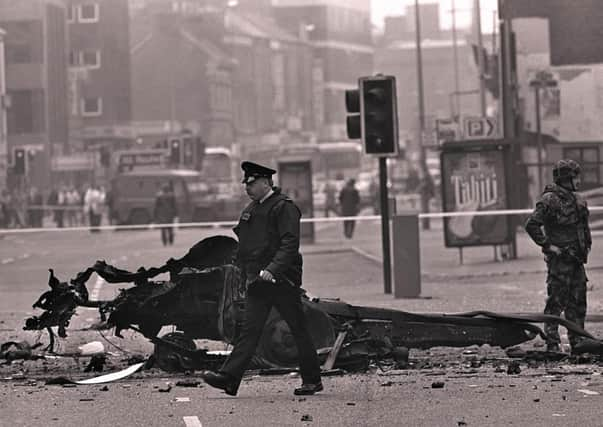IN DETAIL: Read admission from the IRA leadership that by 1993 ‘conflict was over’


The messages date back to roughly 18 months before the IRA’s first ceasefire in 1994 (which it went on to break).
They are among a big stack of formerly classified government material which Ulster University has now put online.
Advertisement
Hide AdAdvertisement
Hide AdThe documents, which were declassified a couple of years ago, can now be perused by the general public at cain.ulster.ac.uk/proni/index.html


They are somewhat odd, in that they do not say how the messages were relayed (ie, by post, in person, over the telephone) or who the individuals sending them were.
It is understood there is some disagreement within republicanism over whether the wording ofn the messages truly reflects the thinking of the Provisionals.
But in any case, this is how the first message read: “Message from the leadership of the Provisional Movement, February 22, 1993.
Advertisement
Hide AdAdvertisement
Hide Ad“The conflict is over but we need your advice on how to bring it to a close.
“We wish to have an unannounced ceasefire in order to hold dialogue leading to peace.
“We cannot announce such a move as it will lead to confusion for the volunteers because the press will misinterpret it as a surrender.
“We cannot meet Secretary of State’s public renunciation of violence, but it would be given privately as long as we were sure that we were not being tricked.”
THE EXCHANGE BEGINS:
A reply came three days later.
Advertisement
Hide AdAdvertisement
Hide AdHeaded simply “British message”, it said: “We understand and appreciate the seriousness of what has been said.
“We wish to take it seriously and at face value... We are working to reply further as swiftly as possible.”
Further messages sought a meeting with Gerry Kelly and Martin McGuinness, but the British response complained of ongoing violence from the IRA, adding that “if violence had genuinely been brought to an end, whether or not that fact had been announced, then dialogue could take place”.
On March 22 a “message from the leadership of the Provisional Movement” said: “It is with total sadness that we have to accept responsibility for the recent action.
Advertisement
Hide AdAdvertisement
Hide Ad“The last thing we needed at this sensitive time was what has happened.
“It is the fate of history that we find ourselves in this position, all we can think of at this time is an old Irish proverb: God’s hand works in mysterious ways.
“Our hope is that this hand will lead to peace and friendship” (the “recent action” was the Warrington bombing on March 20, killing two children).
The next British message was not until May 5.
It said: “Events on the ground are crucial, as we have consistently made clear.
Advertisement
Hide AdAdvertisement
Hide Ad“We cannot conceivably disregard them. We gave in good faith the advice which was sought, taking what we were told at face value.
“It is difficult to reconcile that with recent events...
“We have not received the necessary private assurance that organised violence has been brought to an end.
“We hope that we do so soon and that violence is genuinely brought to an end as, without that, further progress cannot be made.”
IMPASSE AS BODY COUNT CONTINUES TO GROW:
Friction then begins to develop, with the IRA complaining that it was “dismayed” at the length of time which was passing without a British response.
Advertisement
Hide AdAdvertisement
Hide AdSoon after, the IRA messenger declared the group “most displeased” that some details of the messages had apparently been leaked to the press, with the IRA going on to affirm its aim of re-unifying Ireland.
Further complex exchanges followed, with the British messenger (whoever they were) continuing to condemn the failure to call off IRA attacks.
The exchange effectively ends with a British assurance on November 2 that “if a genuine end to violence is brought about within the next few days, a first meeting for exploratory dialogue would take place within a week of Parliament’s return in January”.
Despite declaring “the conflict is over” in February 1993, the IRA did not finish disarming until autumn 2005.
Advertisement
Hide AdAdvertisement
Hide AdFrom 1994 to 2001 (when it agreed to begin decommissioning), the IRA killed at least another 33 people.
More from this reporter:
——— ———
A message from the Editor:
Advertisement
Hide AdAdvertisement
Hide AdThank you for reading this story on our website. While I have your attention, I also have an important request to make of you.
With the coronavirus lockdown having a major impact on many of our advertisers — and consequently the revenue we receive — we are more reliant than ever on you taking out a digital subscription.
Subscribe to newsletter.co.uk and enjoy unlimited access to the best Northern Ireland and UK news and information online and on our app. With a digital subscription, you can read more than 5 articles, see fewer ads, enjoy faster load times, and get access to exclusive newsletters and content. Visit https://www.newsletter.co.uk/subscriptions now to sign up.
Our journalism costs money and we rely on advertising, print and digital revenues to help to support them. By supporting us, we are able to support you in providing trusted, fact-checked content for this website.
Alistair Bushe
Editor